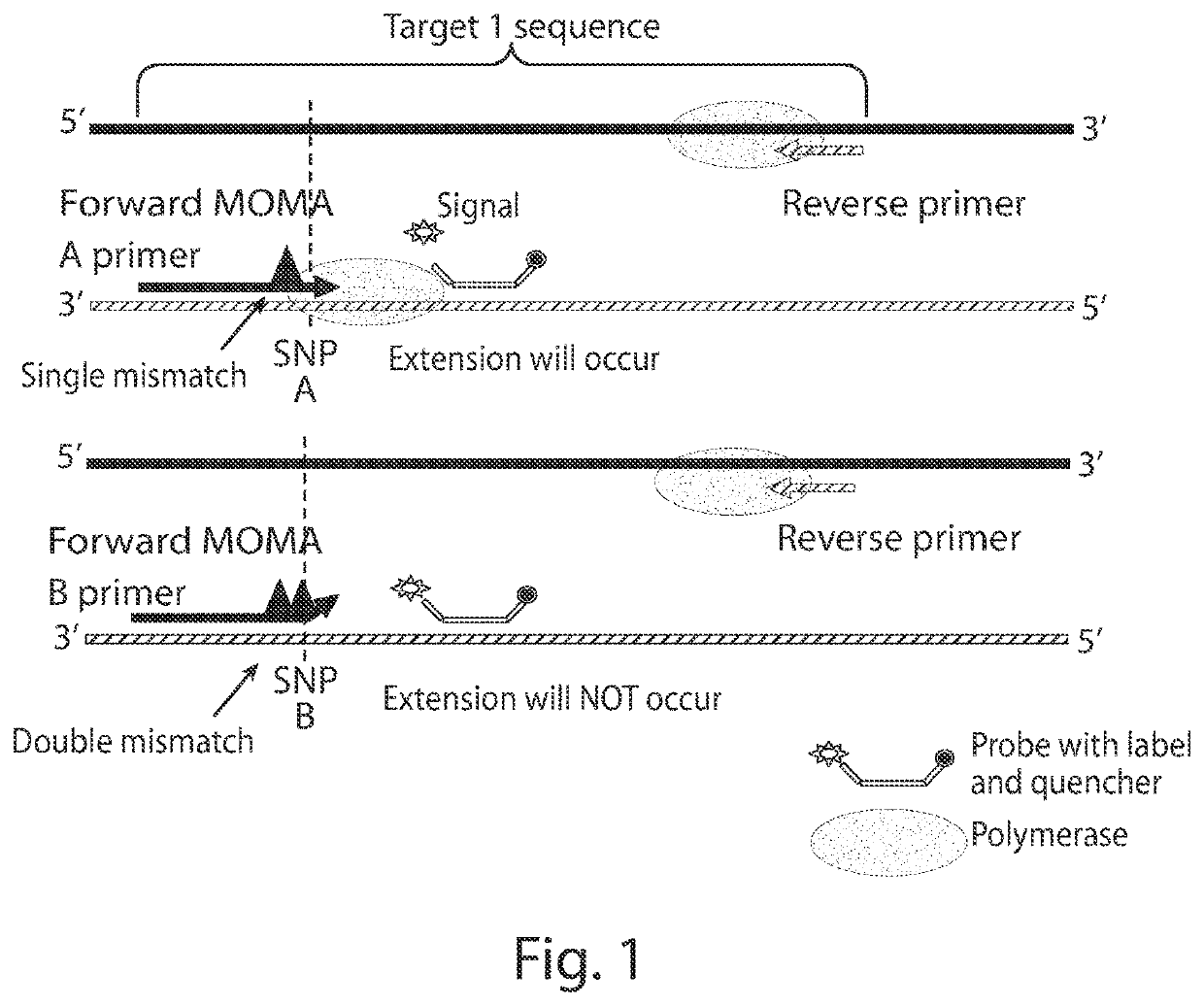Multiplexed optimized mismatch amplification (MOMA)-cancer risk assessment with non-cancer associated targets
- Summary
- Abstract
- Description
- Claims
- Application Information
AI Technical Summary
Benefits of technology
Problems solved by technology
Method used
Image
Examples
example 1
y with Genotype Information
SNV Target Selection
[0131]Identification of targets for multiplexing in accordance with the disclosure may include one or more of the following steps, as presently described. First, highly heterozygous SNPs can be screened on several ethnic control populations (Hardy-Weinberg p>0.25), excluding known difficult regions. Difficult regions include syndromic regions likely to be abnormal in patients and regions of low complexity, including centromeres and telomeres of chromosomes. Target fragments of desired lengths can then be designed in silico. Specifically, two 20-26 bp primers spanning each SNP's 70 bp window can be designed. All candidate primers can then be queried to GCRh37 using BLAST. Those primers that were found to be sufficiently specific can be retained, and monitored for off-target hits, particularly at the 3′ end of the fragment. The off-target candidate hits can be analyzed for pairwise fragment generation that would survive size selection. Se...
example 2
y with Native (Subject) but not Non-Native Genotype Information
Expectation Maximization Method
[0135]To work without non-native genotype information, the following procedure may be performed to infer informative assays and allow for quantification of non-native-specific cell-free DNA in plasma samples. All assays can be evaluated for performance in the full information scenario. This procedure thus assumed clean AA / AB / BB genotypes at each assay and unbiased behavior of each quantification. With native genotype, assays known to be homozygous in the subject can be selected. Contamination can be attributed to the non-native nucleic acids, and the assay collection created a tri-modal distribution with three clusters of assays corresponding to the non-, half, and fully-informative assays. With sufficient numbers of recipient homozygous assays, the presence of non-native fully informative assays can be assumed.
[0136]If the native genotype is homozygous and known, then if a measurement that...
example 3
NA Assay
Principles and Procedures of a MOMA Cf-DNA Assay
[0155]This exemplary assay is designed to determine the percentage of non-native cf-DNA present in a subject's blood sample. In this embodiment, the subject's blood sample is collected in an EDTA tube and centrifuged to separate the plasma and buffy coat. The plasma and buffy coat can be aliquoted into two separate 15 mL conical tubes and frozen. The plasma sample can be used for quantitative genotyping (qGT), while the buffy coat can be used for basic genotyping (bGT) of the subject.
[0156]The first step in the process can be to extract cell free DNA from the plasma sample (used for qGT) and genomic DNA (gDNA) from the buffy coat, whole blood, or tissue sample (used for bGT). The total amount of cfDNA can be determined by qPCR and normalized to a target concentration. This process is known as a cfDNA Quantification. gDNA can be quantified using UV-spectrophotometry and normalized.
[0157]The normalized patient DNA can be used as ...
PUM
| Property | Measurement | Unit |
|---|---|---|
| Fraction | aaaaa | aaaaa |
| Fraction | aaaaa | aaaaa |
Abstract
Description
Claims
Application Information
 Login to View More
Login to View More - R&D
- Intellectual Property
- Life Sciences
- Materials
- Tech Scout
- Unparalleled Data Quality
- Higher Quality Content
- 60% Fewer Hallucinations
Browse by: Latest US Patents, China's latest patents, Technical Efficacy Thesaurus, Application Domain, Technology Topic, Popular Technical Reports.
© 2025 PatSnap. All rights reserved.Legal|Privacy policy|Modern Slavery Act Transparency Statement|Sitemap|About US| Contact US: help@patsnap.com



